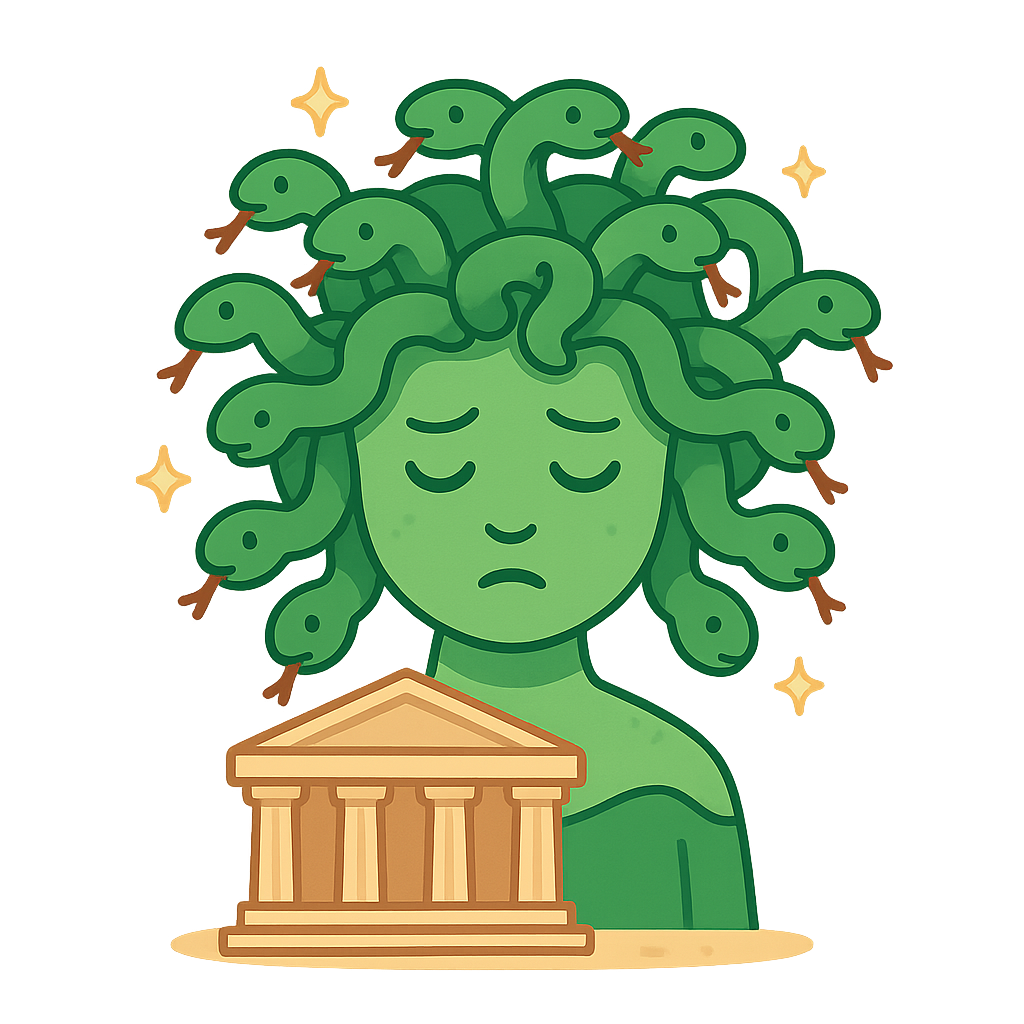The Myth of Medusa
My name is Medusa, and long before whispers turned me into a monster, my home was a beautiful, sunlit temple in ancient Greece. The air inside always smelled of sea salt and olive groves, and the marble floors were cool beneath my feet. I was a priestess for the goddess Athena, and I loved serving her. People would travel for miles just to see the temple's beauty and, they would often say, to see my long, beautiful hair, which shimmered like spun gold in the flickering lamplight. Life was peaceful and full of purpose. But the gods of Olympus can be proud and jealous, and one day, a terrible argument between the mighty sea god Poseidon and Athena herself erupted inside the sacred walls. Athena’s pride was wounded, and in a moment of unfair rage, all her anger was turned on me, an innocent priestess. This is the beginning of the myth of Medusa, a story of how a girl was unjustly turned into a legend.
In her blinding fury, Athena cursed me with a transformation so terrible it would make the bravest heart tremble. My beautiful golden hair, once my pride, twisted and writhed, each strand thickening and coiling until my head was a terrifying nest of hissing, venomous snakes. Can you imagine the shock and horror of that? But that was not the worst of it. My eyes, which once looked upon the world with kindness and curiosity, were given a dreadful power: anyone who met my gaze would instantly turn to solid, lifeless stone. I never wanted to hurt anyone, so with a shattered heart, I fled. I found refuge on a remote island at the edge of the world, a lonely, windswept place of gray rocks and the endless, crashing roar of the waves. My two immortal sisters, the other Gorgons, also lived there, but I was different; I was the only one who had once been human and carried the memory of a different life. I became a creature of frightening bedtime stories and a dire warning in sailors’ tales. I spent my days in solitude, the constant slithering sound of the snakes in my hair a constant, painful reminder of everything I had lost.
For years, my only visitors were foolishly brave men who thought they could defeat me, but they all became stone statues in my desolate garden. Then one day, a young hero named Perseus arrived on my island. He had been sent on what everyone believed was an impossible quest: to bring back my head. But Perseus was cleverer than all the others. He carried a shield so polished it shone like a mirror, a gift from Athena herself. I heard his cautious footsteps echo in my cavernous home, and I prepared for another sad victory. I saw him approach, but he never once looked directly at me. Instead, he watched my reflection in the gleaming bronze of his shield. In it, I saw myself for the first time in ages—the writhing snakes, the haunted, powerful eyes. He also had a pair of winged sandals, a gift from the god Hermes, that let him move as quickly and silently as the wind. It was a strange and silent battle, a sorrowful dance between a determined hero looking into a mirror and a lonely Gorgon who couldn't meet his eyes without destroying him. It was my end, but also the beginning of a new chapter for my story.
Perseus succeeded in his quest, and you might think my story ended there, in that lonely cave. But my power was far from over. My legacy was just beginning to be written. After his victory, Perseus gave my head to Athena, the very goddess who had cursed me. In a surprising twist, she placed my image onto the front of her own powerful shield, the Aegis. The face that had once been a symbol of my personal curse was now transformed into a symbol of ultimate protection, used to frighten away evil and protect the innocent in the heat of battle. My face, with its crown of snakes, was carved onto the walls of temples and the armor of soldiers all across ancient Greece. They believed my powerful gaze could still turn their enemies to stone and keep them safe from all harm. In this way, a symbol of fear had become a symbol of strength and a guardian for the people. My story had become one of power, not just of sorrow.
For thousands of years since, my story has been told and retold, traveling through time. The ancient Greeks shared it around crackling fires, and it was written down by famous Roman poets like Ovid around the 8th year CE. Today, if you look closely, you can see my face everywhere. It’s in museums on ancient pottery, in famous paintings by great artists, and even as the logo for modern companies who want to show they are strong and captivating. Artists and writers are still inspired by my tale. Some see me as a terrifying monster, but others see a powerful woman who was misunderstood and treated unfairly. My myth reminds us that there are always many ways to look at a single story. It teaches us that even the most frightening tales can hold lessons about courage, protection, and inner strength. My story continues to spark human imagination, connecting us to a time of gods and heroes and inviting everyone to wonder about the thin line between monsters and magic.
Reading Comprehension Questions
Click to see answer
